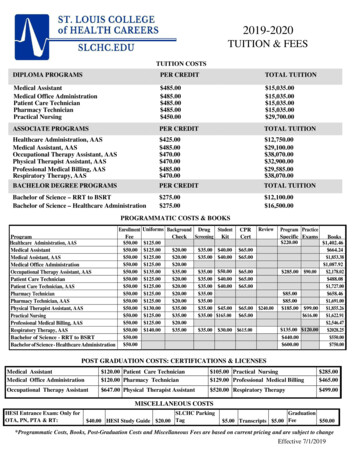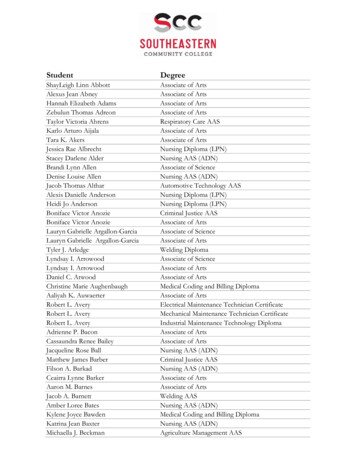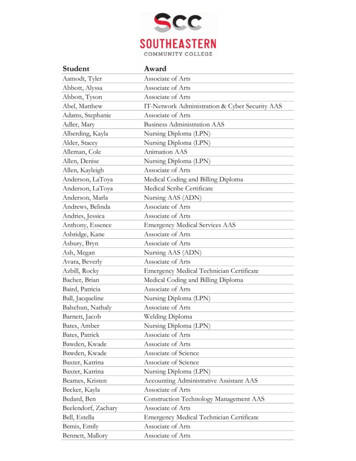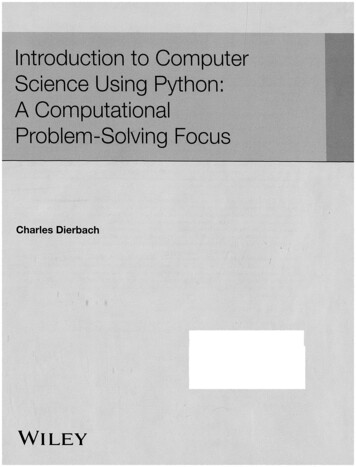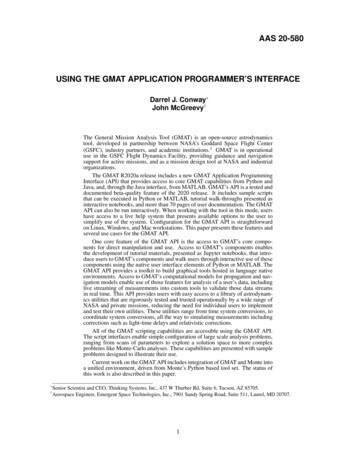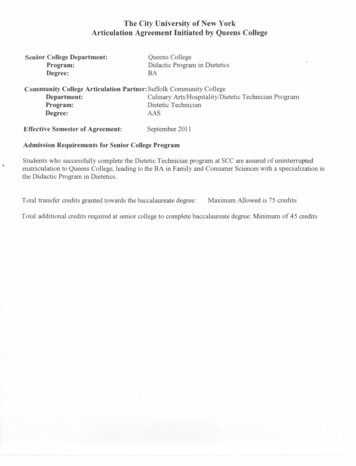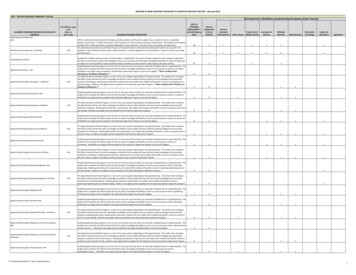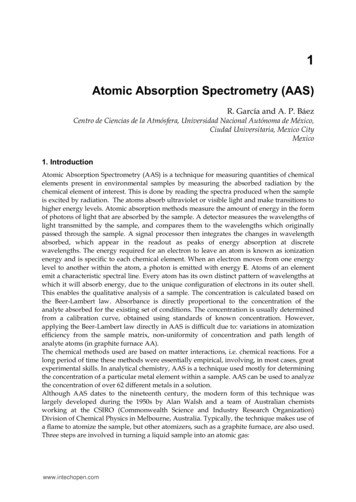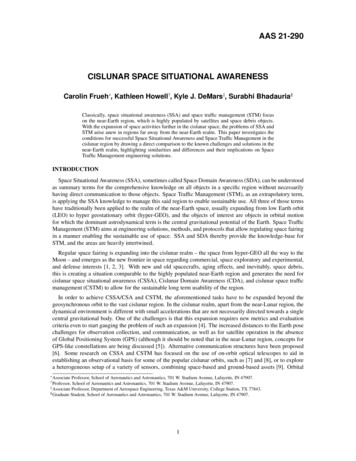
Transcription
AAS 21-290CISLUNAR SPACE SITUATIONAL AWARENESSCarolin Frueh*, Kathleen Howell†, Kyle J. DeMars‡, Surabhi Bhadauria§Classically, space situational awareness (SSA) and space traffic management (STM) focuson the near-Earth region, which is highly populated by satellites and space debris objects.With the expansion of space activities further in the cislunar space, the problems of SSA andSTM arise anew in regions far away from the near-Earth realm. This paper investigates theconditions for successful Space Situational Awareness and Space Traffic Management in thecislunar region by drawing a direct comparison to the known challenges and solutions in thenear-Earth realm, highlighting similarities and differences and their implications on SpaceTraffic Management engineering solutions.INTRODUCTIONSpace Situational Awareness (SSA), sometimes called Space Domain Awareness (SDA), can be understoodas summary terms for the comprehensive knowledge on all objects in a specific region without necessarilyhaving direct communication to those objects. Space Traffic Management (STM), as an extrapolatory term,is applying the SSA knowledge to manage this said region to enable sustainable use. All three of those termshave traditionally been applied to the realm of the near-Earth space, usually expanding from low Earth orbit(LEO) to hyper geostationary orbit (hyper-GEO), and the objects of interest are objects in orbital motionfor which the dominant astrodynamical term is the central gravitational potential of the Earth. Space TrafficManagement (STM) aims at engineering solutions, methods, and protocols that allow regulating space fairingin a manner enabling the sustainable use of space. SSA and SDA thereby provide the knowledge-base forSTM, and the areas are heavily intertwined.Regular space fairing is expanding into the cislunar realm – the space from hyper-GEO all the way to theMoon – and emerges as the new frontier in space regarding commercial, space exploratory and experimental,and defense interests [1, 2, 3]. With new and old spacecrafts, aging effects, and inevitably, space debris,this is creating a situation comparable to the highly populated near-Earth region and generates the need forcislunar space situational awareness (CSSA), Cislunar Domain Awareness (CDA), and cislunar space trafficmanagement (CSTM) to allow for the sustainable long term usability of the region.In order to achieve CSSA/CSA and CSTM, the aforementioned tasks have to be expanded beyond thegeosynchronous orbit to the vast cislunar region. In the cislunar realm, apart from the near-Lunar region, thedynamical environment is different with small accelerations that are not necessarily directed towards a singlecentral gravitational body. One of the challenges is that this expansion requires new metrics and evaluationcriteria even to start gauging the problem of such an expansion [4]. The increased distances to the Earth posechallenges for observation collection, and communication, as well as for satellite operation in the absenceof Global Positioning System (GPS) (although it should be noted that in the near-Lunar region, concepts forGPS-like constellations are being discussed [5]). Alternative communication structures have been proposed[6]. Some research on CSSA and CSTM has focused on the use of on-orbit optical telescopes to aid inestablishing an observational basis for some of the popular cislunar orbits, such as [7] and [8], or to explorea heterogeneous setup of a variety of sensors, combining space-based and ground-based assets [9]. Orbital* Associate Professor, School of Aeronautics and Astronautics, 701 W. Stadium Avenue, Lafayette, IN† Professor, School of Aeronautics and Astronautics, 701 W. Stadium Avenue, Lafayette, IN 47907.‡ Associate§ Graduate47907.Professor, Department of Aerospace Engineering, Texas A&M University, College Station, TX 77843.Student, School of Aeronautics and Astronautics, 701 W. Stadium Avenue, Lafayette, IN 47907.1
propagation needs to be significantly expanded and coupled with interplanetary techniques, with the firststeps being made in this direction [10]. Because of the changed dynamical environment, orbit determinationtechniques need to be significantly adapted in order to be successful in the cislunar realm, such as based onoptical observations alone [11, 12], e.g., for satellite navigation.In this paper, we want to illustrate the concept of exploring orbital families for orbit selection, the effect ofthe different propagation models and coordinate frames and forces, the ground coverage for optical observations under various constraints, and the uncertainty propagation in the cislunar realm. For this purpose, threedifferent types of orbits are introduced, the Distant Retrograde Orbit (DRO) orbit family, and the Lyapunovorbital family, and a transfer orbit from the Earth to an L2 halo orbit. From the latter two, one sample orbit is selected for ground-coverage, uncertainty propagation investigations. In terms of propagation models,the circular restricted three body propagation is compared with different numerical propagation models ofvarious fidelities. As for coordinate frames, the rotating coordinate frame and the inertial J2000.0 frame areused.THE CISLUNAR DYNAMICAL ENVIRONMENTIn the following, the force environment in the cislunar space is illustrated in order to provide a comparisonto the near-Earth region. For the illustration, the accelerations experienced by a space object are computedthroughout the cislunar realm.For the acceleration computation, a reference date, March 20, 2020, at midnight UTC, has been used.The forces that have been taken into account for the simulation are the Earth gravitational potential, explicated out in the central potential and J2 term, the solar and lunar point mass gravitational force, Jupiter’sgravitational force, solar radiation pressure, and drag in the altitude up to 1000 km from the Earth’s surface.The parameters for the solar radiation pressure, an area-to-mass ratio of 0.02 m2 /kg is assumed (a standardvalue corresponding e.g., to a GPS satellite) with a diffuse reflection parameter of Cd 0.8 and a one-meterdiameter in a cannonball model. Drag is computed via the circular orbit velocity at the given location.Fig. 1a shows the combined accelerations due to all the aforementioned forces except drag. One can clearlysee the gravitational wells created by the Earth and the Moon. Selecting the color cording to a yellow cutoffof 0.009 m/s2 , illustrates the variety of accelerations present in the cislunar region that is far from beingcompletely flat. Figs. 1b and 1c are singling out the accelerations due to Jupiter, which can be seen to bebehind the Moon at the time of the acceleration, and the solar radiation pressure, which shows the crossrelated accelerations from the Sun. Naturally, the solar radiation pressure acceleration with an opposeddirection indicates the direction of the solar gravity.(a) All accelerations(b) Jupiter(c) Solar radiation pressureFigure 1: Accelerations due to a) combined accelerations due Earth, solar, lunar and Jupiter gravity and solarradiation pressure b) Jupiter and c) solar radiation pressure as a function of position, the colorbar indicatesaccelerations in sm2 .This can be compared to the situation in the near-Earth environment. In the near-Earth environment, thedominant term is Earth gravitational potential with its strongest central term, followed by drag and or higherorder gravitational terms, depending on the satellite layout. When focusing on the acceleration direction,2
it is clear that the dominant direction points towards the central body, even in the presence of drag. Onlyextremely high area-to-mass ratio objects could force objects into significant deviations from a central bodyacceleration sometimes referred to as displaced orbits [13].CIRCULAR RESTRICTED THREE BODY PROBLEM, COORDINATE FRAMES, AND PROPAGATION MODELSThe Circular Restricted Three-Body Problem (CR3BP) model is useful for preliminary analysis of trajectories in the Earth-Moon system. The motion of a spacecraft, assumed with a negligible mass, is governedby both the Earth and the Moon’s gravitational forces simultaneously. The Earth and the Moon are termedthe primaries P1 (mass m1 ) and P2 (mass m2 ), respectively. The primaries are assumed to move on circular orbits relative to the system barycenter (BA). The barycentric rotating frame, R, is defined such thatthe rotating x-axis is directed from the Earth to the Moon, the z-axis is parallel to the direction of the orbital angular momentum of the primary system, and the y-axis completes the orthonormal triad. The statevector x [x, y, z, ẋ, ẏ, ż]T for the spacecraft relative to the Earth-Moon barycenter is defined in terms ofthe rotating coordinates. By convention, quantities in the CR3BP are non-dimensional such that, firstly, thecharacteristic length is the distance between the Earth and the Moon. Secondly, the characteristic mass is thesum m1 m2 , and thirdly, the characteristic time is determined such that the non-dimensional gravitationalconstant is equal to unity.The mass parameter is then defined as µ vector form is then:m2m1 m2 .The first order non-dimensional equation of motion inẋ f (x),(1)f (x) [ẋ, ẏ, ż, 2nẏ Ux , 2nẋ Uy , Uz ]T ,(2)with the vector fieldwhere n denotes the non-dimensional mean motion of the primary system. The vector field is expressed interms of the pseudo-potential function:U (x, y, z, n) 1 u µ 1 2 2 n (x y 2 ),dr2(3)where the non-dimensional quantities d and r denote the Earth-spacecraft and Moon-spacecraft distances,respectively. The quantities Ux , Uy , and Uz represent the partial derivatives of the pseudo-potential functionwith respect to the rotating position coordinates. Only one integral of motion is known to exist, named theJacobi constant, C, which is evaluated as:pC 2U v 2withv ẋ2 ẏ 2 ż 2(4)The Jacobi constant is a constant of motion in the rotating frame. It offers useful information concerning theenergy level associated with a periodic orbit or a trajectory arc in the CR3BP.For visual interpretation and clarity, it is frequently convenient to view the trajectories in the inertial frame.A transformation from rotating to inertial coordinates is easily accomplished. An inertial frame, I, with thecoordinate directions denoted by X̂, Ŷ , Ẑ and the rotating frame R are related such that the angular velocityof the rotating frame relative to the inertial frame is ω : nẑ nẐ. Under the assumption of the CR3BP,the mean motion n is constant and can be expressed as n θ̇, with the angular velocity θ̇. With the nondimensional value n 1, it is observed that the angle θ ranges from 0 to 2π over each revolution of theEarth-Moon system in the inertial frame. The inertial frame is defined as the J2000.0 reference frame in itsclassical form centered on the Earth.In the course of this paper, for precise orbit propagation, two models are used utilizing numeric integrationin the inertial J2000.0 frame (centered on the Earth) in Cartesian Coordinates. For a simple comparison to theCR3BP, first, a simplified dynamics model is used, in which only the point gravity of the Earth and the Moon3
is taken into account with a simplified lunar position. In the full ephemerides model, the Earth gravitationalpotential, including the main harmonic terms of (2,0) (2,2) (3,0) (3,1) (4,0) and the point gravitational sourcesof the Sun, the Moon and Jupiter, and SRP have been taken into account. For the Jupiter’s, lunar, and solarposition, precise SPICE ephemerides are used. The solar radiation pressure model is a cannonball model witha one-meter diameter with a diffuse reflection coefficient of 0.5 and an area-to-mass ratio of 0.02 m2 /kg.ORBIT SELECTIONAs is apparent from the preliminary analysis, accelerations throughout the cislunar region are much morevariable than in the near-Earth domain. Such variability offers a much broader array of orbits and transferpaths throughout the region. A number of orbital families, for example, are not available under a two-bodyor conic model. Rather, some less familiar orbital families emerge with different types of characteristics tobe leveraged for new types of activities. Conversely, this variation also delivers new challenges for efforts tosupport orbital catalogs and predictions of behaviors in this regime. In an effort to explore the challenges,some orbits are selected to examine the acceleration levels as well as prediction. The sample obits for somepreliminary analysis include Distant Retrograde orbits (DROs) and Lyapunov orbits. In addition, a transferorbit is introduced as a type or orbital path through the entire cislunar region.resonant orbits are introduced as some options that will flow, over time, through the entire cislunar region.Earth-Moon Distant Retrogrades Orbits (DROs)Distant retrograde orbits, or DROs, have been the focus of much discussion recently due to the inherentlinear stability of the many of the DROs. These orbits are precisely periodic in the CR3BP but generally retaintheir characteristics when transitioned to an ephemerides model. A family of planar DROs ranges throughoutthe region and encompasses the Earth-Moon L1 and L2 libration points. Each family in the CR3BP includesan infinite number of members that can be distinguished by a number of factors including period and energylevel. Some of these orbits pass near the Earth and then the far side of the Moon. It is also true that there aremembers that pass nearly through the L1 and L2 libration points. A subset of the family of distant retrogradeorbits is plotted in Fig. 2a. Note the direction of motion. One member of the family is highlighted in black;it is the sample orbit chosen for further exploration. This orbit has been selected for its properties to inhabitthe cislunar region between the Earth and the Moon, with the passage outside the libration points.For the propagation, the CR3BP and the simple ephemerides model is used. The orbit has been propagatedfor about 26.22 days, the start epoch is MJD 58849.0 (Jan 1 20202, 0h). The propagation model influences theorbital development, as the comparison in Fig. 2b shows, however, the general shape of the orbit is preservedeven using a simpler ephemerides model. This is the case because the DRO unfolds in the middle regionbetween the Earth and the Moon, where smaller accelerations are dominating, as described in the previoussection. Of course, a corrections process can be implemented in the ephemerides model to retain specificcharacteristics if required [14, 15].4
(a) DRO Orbital Family, Rotating Frame(b) Selected DRO, Inertial FrameFigure 2: a) Family of precisely periodic Distant Retrograde Orbits (DROs) in the CR3BP. Colors indicatethe energy range in terms of the Jacobi Constant. One member of the family is selected (black) that passesnearly halfway between the Earth and the Moon. b) the selected DRO orbit propagated with the two differentdynamical models (green simplified dynamics, blue full ephemerides model) in the inertial J2000.0 frame.Earth-Moon Lyapunov OrbitsA planar family of Lyapunov orbits originates in the vicinity of each of the Earth-Moon collinear librationpoints. Consistent with DROs, the Lyapunov orbits are precisely periodic in the CR3BP and also retain theirgeneral characteristics when transitioned to an ephemerides model. Each family in the CR3BP includes aninfinite number of members, distinguished by a number of factors including period and energy level. In theEarth-Moon system, a portion of the L1 family of Lyapunov orbits is plotted in Fig. 3a. The family extends allthe way to the Earth. The family member that has a close lunar passage is selected for further investigation.It is an orbit that covers the cislunar space, but the close lunar passage would allow for lunar surveillance orinteraction with lunar orbiters; a characteristic which is interesting for current and future missions.The propagation model has significant influence on the orbital development, as the comparison in Fig. 3bshows, the time over which the orbit has been propagated is about 32.07 days, the start epoch is MJD 58849.0(Jan 1 20202, 0h). The simplified dynamics model neglects the lunar gravity, which has a huge effect on theorbit because of the close lunar fly-by and leads to a sharp point of departure after about half of the orbitalperiod. Using the higher fidelity model, where besides the gravitational potential of all three main bodies,Earth, Sun and Moon, also SRP is taking into account, a much smoother trajectory is reached.5
(a) Lyapunov Orbital Family, Rotating Frame(b) Selected Lyapunov orbit, Inertial FrameFigure 3: a) A family of L1 Lyapunov orbits in the Earth-Moon CR3BP. Colors indicate the energy range interms of the Jacobi Constant. One member of the family is selected (black) that passes relatively close to theMoon. b) the selected Lyapunov orbit propagated with the two different dynamical models (green simplifieddynamics, blue full ephemerides model) in the inertial J2000.0 frame.The Earth-L2 Halo Transfer OrbitTo investigate a different type of orbit in the cislunar regime, a transfer orbit is constructed from LEO toa three-dimensional L2 southern halo orbit [16, 17]. A projection of the transfer onto the x-y plane appearsin Fig. 4. The departure orbit is circular and 210 km altitude. The arrival L2 southern halo orbit possesses aperiod of 14.77 days; A member of the L2 halo family, the Jacobi constant value corresponding to this orbitis JC 3.13713. As apparent in the figure, the transfer includes two maneuvers, one to depart the Earth orbitand one to insert onto the halo orbit stable manifold. The Earth departure maneuver is quite standard; theinsertion maneuver at nearly 700 m/s has not been optimized and serves as a suitable initial guess for such atransfer. Consistent with the previous CR3BP orbits, the initial states for the transfer were straightforwardlyused in the two different dynamics models and propagated forward in time without any attempt to updatethe state prior to propagation and the resulting paths are plotted in Fig. 5. This is the resulting orbit withoutinclusion of the second maneuver. As a result, the orbit loops back to the Earth after the lunar passage.Employing a corrections process, the transfer would blend smoothly and, with a updated maneuver, flow intothe L2 orbit if this effort was focused upon a transfer. Rather, in this analysis, the path is employed to assesssurveillance capabilities; as such, the propagated arcs are sufficient.6
Figure 4: Transfer orbit between LEO and an L2 southern halo orbit in the Earth-Moon CR3BP.Figure 5: The selected Transfer orbit propagated with the two different dynamic models, simplified dynamicsand full ephemerides model in the inertial J2000.0 frame, just after the first maneuver.SURVEILLANCE OF THE SELECTED CISLUNAR ORBITSOne of the key elements in cislunar Space Surveillance is the coverage with observations. One of thechallenges are the large distances to the objects in the cislunar space. In this paper, the focus is on groundbased optical measurements. Those sensors are not the best suited ones, but the ones most widely available.For complete surveillance, supplementation of sensors on the Moon and on cislunar orbits are required.In order to model the optical sensor, the magnitude of a representative space object on the selected sampleorbits is computed. The magnitude of a space object is:mag magsun 2.5 log10 (Isc)Isun(5)where magsun is the apparent reference magnitude of the Sun, Isc is the irradiance reflected off the spacecraftand ISun is the Sun’s reference irradiance. In order to compute the irradiance that is reflected off the object,7
an assumption about the albedo-area, the shape and attitude of the space object has to be made. In this paper,we assume, in agreement with the solar radiation pressure modelling of a spherical object. This is a goodbaseline scenario. Overall, for satellites in a box wing configuration, higher irradiation is received in thecase of a specular glint off the solar panels or the antennas. However, those glints are, per definition, notcontinuous and only occur during very limited times over one period, if at all, depending on the Sun-objectobserver geometry. A Lambertian sphere on the other hand has the advantage of, other than in the time ofcomplete opposition, always reflecting a fraction of the Sun’s irradiation towards the observer; a fact notgiven for a non-spherical object. In future work, the exact orientation of a given satellite configuration willbe evaluated. The irradiance of the object can hence be expressed via the the following relation [18]:Isc ISun 2 Cd 2r (sin α (π α) cos α)d2scobs 3 π 2(6)dscobs is the distance between the object and the observer, r is the object’s radius, and α is the phase anglebetween the Sun and the observer at the object’s location. It is important to note that the solar constant I0 ,needs to be scaled to the actual distance between the Sun and the object dSunsc for the reference irradiance2as the solar constant is defined at one Astronomical Unit (AU). This is relevant whenISun I0 dAU2Sunsccomputing the absolute irradiation of the object.For the visibility besides the overall magnitude also the background irradiation entering the sensor arerelevant, creating the so-called detection signal to noise ratio (SNR) in its definition mean divided by thestandard deviation [19]:SNR S,S N(7)Where S and N denote the mean (and variance) of the Poisson distributed signal of interest and the noise,respectively. The signal of interest is in our case the signal contained in the object image on the detector andthe noise is in those same pixels.The detection limit is directly dependent on the SNR and is dictated by the exact setup of optic’s aperture,sensor type and sensitivity in combination with the specific image processing software. While, for methodologies employing stacking, detection limits can be pressed to be below an SNR of 1, this requires precisetracking and is inversely proportional to the time spent on observing the object, which is not realisticpor feasibile in many cases. In this paper, a realistic more general signal dependent threshold of SN R S/2 isused.Night time visibility constraints are often listed as a separate observation constraint, however, strictlyspeaking, night time constraints are also SNR constraints. Daytime imaging of satellites in off-Sun directionsis possible, however, the higher background requires a much higher object magnitude to reach the sameSNR. In general, daytime observations require magnitudes of 8 and brighter. In the investigations shownin this paper, none of the observation reached this magnitude, and brightest magnitudes are of the order of14 and higher. For this reason, night time constraintsare applied, requiring observations to take place afterpastronomical sunset. For the SNR a limit of S/2 is used, which serves as a lower bound.One of the most relevant background sources for cislunar observations is the lunar background, as observation directions close to the moon are more frequent. The lunar stray light is computed for each viewingdirection [20].Besides the SNR, visiblity constraints include, as the observations are assumed to be ground-based, localweather and local horizon constraints. The weather is highly variable and not taken into account here. A localhorizon constraint of 0 degrees above horizon has be employed, again serving as the lower limit.The Seleted DROFor the selected DRO orbit, Fig. 6 shows the magnitudes as a function of the time, measured from midnightJan 1, 2020 in hours, for various Cd values (see Eq. 6), local horizon constraints. The radius of the sphere8
is assumed to be 3.54 meters. The black bars indicate background night time sky’s moon brightness in theviewing direction to the object when observed from a station located at latitude 40.4310 degrees North andLongitude 86.9149 East. The gray bars indicate the night time, during which observations are possible. Thelowest magnitude is reached at all times, by the sphere with the highest reflectivity, of course. What is shownis that the moons background brightness significantly interferes with the observations from around 200 to 300hours. Overall, with a telescope with limiting magnitude of 16 only a fraction of the orbit can be covered withobservations even for the most reflective objects, at the beginning of the time interval and after 650 hours.Figure 6: The selected DRO: Magnitude of a 3.54 meter radius object as a function of time. The Skybrightness solely based on the Moon in the viewing direction is shown with the observation location at about40.4 deg N, 86.9 E.Figure 7: The selected DRO: Trajectory of the object and visibilities for a ground-based observer witha limiting magnitude of 20 and lunar background light, for a 1.8 meter radius object and Cd 0.5 anda minimum elevation of zero degrees. Ground-based sensor locations with visiblities are yellow, the oneswithout are marked in blue (Earth size not to scale), the trajectory, for which at least one ground-based sensorhas a visibility is marked pink, otherwise blue.9
The detectability of the object, not surprisingly, is highly dependent upon the location on the Earth, wherethe sensor is located. Fig. 7 shows the visibility of the DRO a 1.8 meter radius object with a reflection coefficient Cd 0.5, constrained to a zero elevation angle along withpmagnitude of the object that is larger thanthe Moon-induced background sky brightness with the SN R S/2 constraint and a limiting magnitudeof 20. The orbit which can be covered by observation located at the center of each Earth grid point is markedin pink and the corresponding sensor locations in yellow. Regions with no observation coverage by any earthsensor location is marked in black. More than in near-Earth surveillance, it is obvious a global network ofsensors is not optional. Furthermore, even with a global coverage, certain observation gaps exist, most significantly at regions after completing about half of the orbital period, in the region farthest from the earth.However, even when the object is closer, e.g. because of illumination conditions, visibility is not guaranteed,see Fig.7.The Selected Lyapunov OrbitFor the selected Lyapunov orbit, the same magnitude calculations have been performed for various Cdreflection coefficients for a spherical object with a radius of 3.54 meters, see Fig. 8. The ground-basedobserver has been placed again at latitude 40.4310 degrees North and Longitude 86.9149 degrees East.Shown are the night times via gray bars and the background moon light’s magnitude in the viewing directionto the object in black.Figure 8: The selected Lyapunov orbit: Magnitude of a one 3.54 meter radius object as a function of timewith the observation location at about 40.4 deg N, 86.9 deg E.Because the magnitude is largely dominated by the distance between the object and the observer, for asensor with a limiting magnitude of 16, one has only the early part of the trajectory to allow for observations,even with a sensor as sensitive as magnitude 20, only barely the last part of the orbit is allowed for observations. As the distance to the earth has significantly increased, no lower magnitudes are reached even for themost reflective objects. At the region, where the object is farthest from the earth, around 500 hours, in combination with the phase angle, no observations are possible, with the object becoming as faint as magnitude30. Towards the end of the propagation period, the object stays faint while also the moonlight thwarts anyobservation possibility. This is comparable to other sensor locations, as shown in Fig. 9.Fig. 9 shows the global visibility for a 1.8 meter radius object and a reflection coefficient Cd 0.5. Thevisiblity constraints are a limiting magnitude of 20, elevation constraints of 0 degrees local elevation anda magnitude of the objectp higher than the Moon-induced background sky brightness according to the SNRconstraint of SN R S/2 (compare Eq.7). Pink indicates visibility by at least one ground-based sensor,10
Figure 9: Trajectory of the object and visibilities for a ground-based observer with a limiting magnitudeof 20 and lunar background light, for a 1.8 meter radius object and Cd 0.5 and a minimum elevation ofzero degrees. Ground-based sensor locations with visiblities are yellow (none present at the final time, shownhere), the ones without are marked in blue (Earth size not to scale), the trajectory, for which at least oneground-based sensor has a visibility is marked pink, otherwise blue.black indicates no sensor can provide observations on the object. Sensors are located at the center of eachgrid point on the Earth surface. It is obvious that even with a ground-based sensor network of sensors withexcellent conditions (limiting magnitude 20), the object cannot be covered with observations towards the endof the propagation period. Observation coverage is reasonable up to this point. It can, however, again only beachieved with a global sensor network.The Selected Transfer OrbitThis can be compared to an object in the selected transfer orbit with the same spherical object with of3.54 meters radius, see Fig.10. with the same ground-based observer at latitude 40.4310 degrees North andLongitude 86.9149 degrees East. Shown are the night times via gray bars and the background moon light’smagnitude in the viewing direction to the object in black.Not surprisingly, the object is bright and very well to be observed at the times when it passes by the earth,however in the far lunar passages, the magnitude increases, making it impossible for sensors with a moderatelimiting magnitude to keep track of even this large object, especially when reflectivity i
Space Situational Awareness (SSA), sometimes called Space Domain Awareness (SDA), can be understood as summary terms for the comprehensive knowledge on all objects in a specific region without necessarily having direct communication to those objects.
